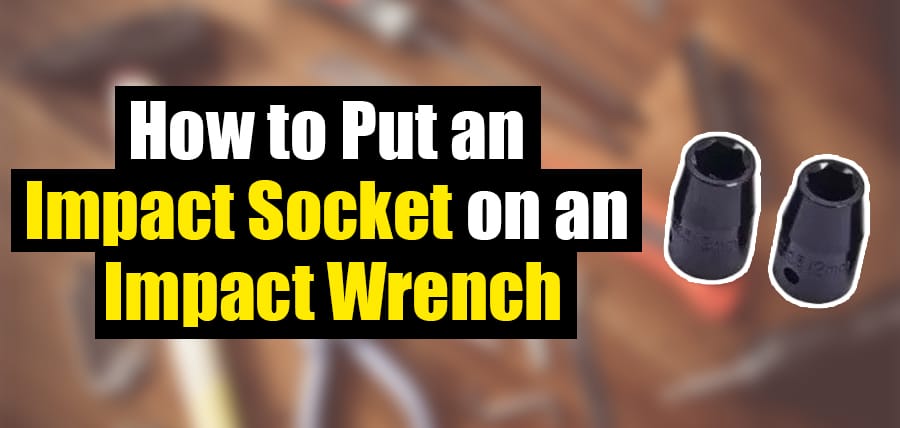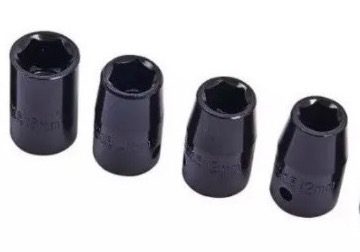The minute you hold an impact socket and a standard socket at the same time, you realize just how much better impact sockets are. I mean, their durability and performance are simply amazing.
However, a common question that often arises is about the best way to put a socket on an impact wrench.
I mean, you want to ensure you’re using these incredible tools to their fullest potential, right?
Well, this article breaks down everything you need to know, and I mean everything, about these bad boys.
Not only I will talk about what sets impact sockets apart, but I will also show you how to put a socket on an impact wrench like a seasoned pro so you can take advantage of their amazing attributes to remove lug nuts and bolts.
Let’s get right into it.
What are Impact Sockets?
What the heck are impact sockets?
That’s a question that’s probably been bugging you since you started your journey as a tradesman.
I mean, come on, we’ve all been there, scratching our heads trying to figure out the difference between standard and impact sockets.
Impact sockets, my friends, are built to work with those impact wrenches that pack serious torque levels with their hammering action which is key to removing stubborn nuts and bolts.
Now, let’s talk about what sets impact sockets apart:
- Material: Impact sockets are made of a tough, flexible material called chrome-molybdenum (or chrome-moly) steel. It’s like the bodybuilder of steel, able to withstand the brute force of an impact wrench without cracking or shattering.
- Wall thickness: These bad boys have thicker walls, which means they’re built to handle the high torque and vibrations from an impact wrench.
- Finish: Impact sockets sport a sleek, black oxide finish that not only fights off corrosion but also keeps the glare down.
- Fit: Impact sockets usually come in a 6-point design, giving you a better grip and contact with those pesky fasteners, so you’re less likely to slip or round off the corners.
How to Put a Socket on an Impact Wrench
I know the struggle of putting a socket on an impact wrench is real, especially for beginners.
But fear not, because we’ll walk you through every damn step to make sure you’re using that impact wrench like a pro.
Selecting the Appropriate Socket
Before you can attach a socket to an impact wrench, you need to choose the right one for the job.
Here’s what you need to know:
- Standard sockets are no match for impact sockets when it comes to working with impact wrenches. So, if you’re planning on removing lots of stubborn lug nuts and bolts, then an impact socket might be your best bet
- Common socket sizes include 1/4″, 3/8″, and 1/2″, but always double-check the size you need for your specific task. You can measure the nut/bolt head’s width (from one flat side to the opposite flat side) to find the right socket size.
- Of course, match the socket drive size with your impact wrench’s drive size, otherwise you run the risk of damaging both the socket and the impact wrench, and potentially causing injury to yourself or others.
Attaching the Socket to the Impact Wrench
Now that you’ve got the right socket, let’s get it on that impact wrench:
- Make sure the wrench is unplugged or disconnected from its power source, as this is the best way to prevent any accidental activation or injury while you’re setting things up.
- Line up the square-shaped end of the socket with the shaft of the wrench, making sure they’re properly aligned. You want to ensure a secure connection between the socket and the wrench to avoid slippage or damage during use.
- Press the socket onto the wrench until you hear a click or feel the locking mechanism engage. This ensures that the socket is securely attached to the wrench, minimizing the risk of it coming loose while you’re working.
Using Impact Sockets with Other Tools
While impact sockets are made for impact wrenches, they can also play nice with other tools, like impact drivers and drills.
This versatility allows you to get the most out of your tool collection and makes impact sockets an even more valuable addition to your toolbox.
However, keep in mind there may be some limitations when using impact sockets with tools other than impact wrenches, such as:
- Lower torque capabilities: Impact drivers and drills might not deliver the same amount of torque as an impact wrench. This means that, while you can still use impact sockets with these tools, you may not be able to tackle heavy-duty tasks that require higher torque levels.
- Compatibility with adapters: In most cases, you might need an adapter to connect an impact socket to an impact driver or drill. These adapters are readily available, but it’s essential to choose a high-quality, impact-rated adapter to ensure a secure connection and prevent damage to the tools or sockets.
- Safety considerations: When using impact sockets with other tools, it’s crucial to follow safety precautions just like you would with an impact wrench. Wear appropriate personal protective equipment, such as safety glasses and gloves, and always make sure the socket is securely attached to the tool before starting any work.
By understanding these nuances and adapting your techniques, you can effectively use impact sockets with a variety of tools and expand your capabilities in the workshop or on the job site.
Tips and Tricks for Working with Impact Wrenches and Sockets
You’ve come a long way, but don’t go just yet, because I’m about to share some tips and tricks that’ll have you working with impact wrenches and sockets like a boss in no time:
- Use a socket ring for added security when working in heavy-duty applications as they will help keep your sockets locked in place, so you can focus on showing that hardware who’s boss.
- To avoid over-tightening or loosening, use a torque wrench for precision as it will help you find that perfect balance and avoid damaging your fasteners or, worse, your precious tools.
- Keep your impact sockets and wrenches well-cleaned and lubricated to ensure they’re always ready for action. Give them some love by keeping them clean and well-lubricated, and they’ll return the favor by being reliable partners in your projects.
By following these tips, you’ll not only improve the way you work with impact wrenches and sockets, but you’ll also become a more efficient and confident DIYer, ready to tackle whatever challenges come your way.
Frequently Asked Questions
Why do impact sockets have a hole?
Ah, the mysterious hole in impact sockets. I’m here to tell you that you shouldn’t worry about it as it’s not there just for show.
The hole serves a practical purpose: it’s for a pin and O-ring retention system.
The pin goes through the hole, and the O-ring is placed around the pin to keep the socket securely attached to the impact wrench. This way, you can be confident your socket won’t go flying off mid-job.
Why are impact sockets 6 point?
Impact sockets are typically 6 point because it offers a better grip on nuts and bolts, allowing the socket to apply more torque without slipping or rounding off the fastener.
It is this design that helps the socket grip the nut or bolt better, so it doesn’t slip or strip the edges when you’re trying to tighten or loosen it
Why do people use 12 point sockets?
You might wonder why anyone would use a 12 point socket when a 6 point offers such a great grip.
Well: 12 point sockets are all about versatility and convenience as they allow for twice as many engagement positions as a 6 point socket, making it easier to find the right angle when you’re working in tight or awkward spaces.
But keep in mind that 12 point sockets aren’t as well-suited for high-torque applications as they have less surface area in contact with the fastener than 6 point sockets. This means that under high-torque applications, there is a greater risk of the socket slipping or rounding off the corners of the fastener.


